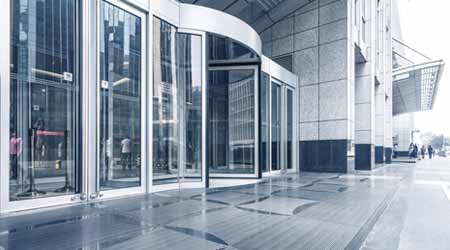 Facility managers should identify requirements for factors like durability and aesthetics based on the conditions in which the door and hardware will operate.
Facility managers should identify requirements for factors like durability and aesthetics based on the conditions in which the door and hardware will operate.Special Attention Required for Fire Doors and Door Hardware Selection
Consult the 2007 edition of NFPA 80 for requirements on annual fire door inspections.
Fire doors require special attention. As part of the building’s fire protection system, fire doors are designed to stop or to slow the spread of fire, smoke, and toxic fumes. The problem is that, like other doors, fire doors largely go ignored. Door stops are installed by occupants to prop open the doors. Hinges loosen, opening gaps between doors and frames. Latching mechanisms wear and fail to fully latch a door closed. The result is that, in the event of an emergency, the fire door will not perform as intended.
Recognizing that improper fire door operation was a significant safety issue, the 2007 edition of NFPA 80 introduced the requirement for annual fire door inspections. The latest edition, NFPA 80 2016, the Standard for Fire Doors and Other Opening Protectives, details what must be inspected and the records that must be kept.
Additionally, insurance companies are starting to require compliance before they will underwrite commercial buildings. Accreditation by the Joint Commission and Centers for Medicare and Medicaid Services also requires compliance. Compliance is more than just ensuring the door closes and latches; it requires verification of a number of items, including:
- A legible fire door label.
- No missing parts.
- Door, frame, hinges, hardware, and threshold are secure, aligned, and working.
- Proper clearances between the door and the frame and threshold.
- No breaks in the door surface or frame.
- Glazing and frames are intact and properly attached.
- Self-closing devices completely close and latch the door.
- No field modifications have been performed.
- Gaskets and edge seals, where required, are properly attached and complete.
- Signage attached to door with adhesive, not screws.
By setting up a comprehensive inspection and maintenance program for all doors, managers achieve the benefits of bringing their facilities into compliance, reducing the number of emergency repair calls involving doors, reducing energy losses through exterior doors, and reducing overall door maintenance costs.
James Piper, PhD, PE, is a writer and consultant who has more than 35 years of experience in facilities management. He is a contributing editor for Building Operating Management.
Email comments and questions to edward.sullivan@tradepress.com.
Related Topics:














